When you think of a piano, you think of it closed – a big black box. Sits in the corner. Its colour is only revealed when you uncover the keyboard, and the contrast of the white and black keys is offset against the rest of the big black box. Subtle, minimalist, and so on.
That’s not how it used to be. Our fondness for shiny black boxes could be tempered by looking at what keyboards used to be: works of art.
Early keyboards took advantage of the blank expanse of the lid to use it for art. It could be art about music, art about culture, or art about history.
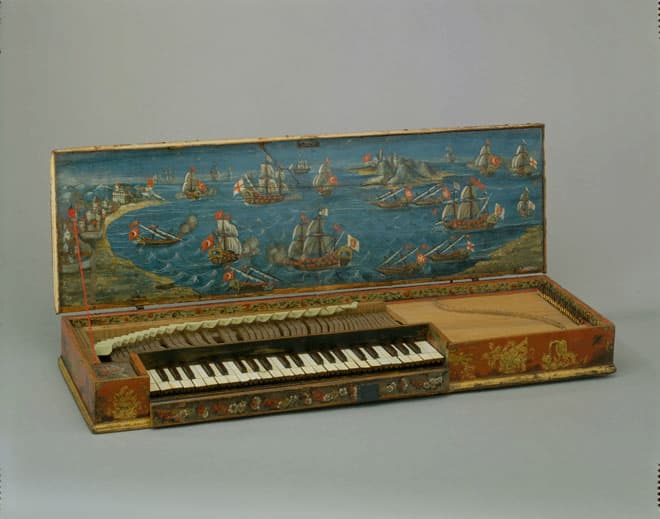
Lepanto clavichord, unknown maker, end of 16th century? (Paris: Music Museum at the Philharmonie)
In this small clavichord by an unknown maker, made at the end of the 16th century, the open cover shows a full sea battle. This sea battle gave the clavichord its name, i.e., the Lepanto. This painting depicts the battle of the Turkish fleet (red flags with a crescent) against the ships of the Christian Coalition, led by the Republic of Venice and the Empire of Spain. The battle, on 7 October 1571, was a major defeat for the Turks and was the last major naval engagement in the West to be fought between rowing vessels. More than 400 warships were involved and the battle ended the expansion of the Ottoman Empire into the Mediterranean.
Anonymous: Longtemps y a que je vis en espoire [16th Century] (arr. T.R. Charlston for clavichord) (Terence R. Charleston, clavichord)
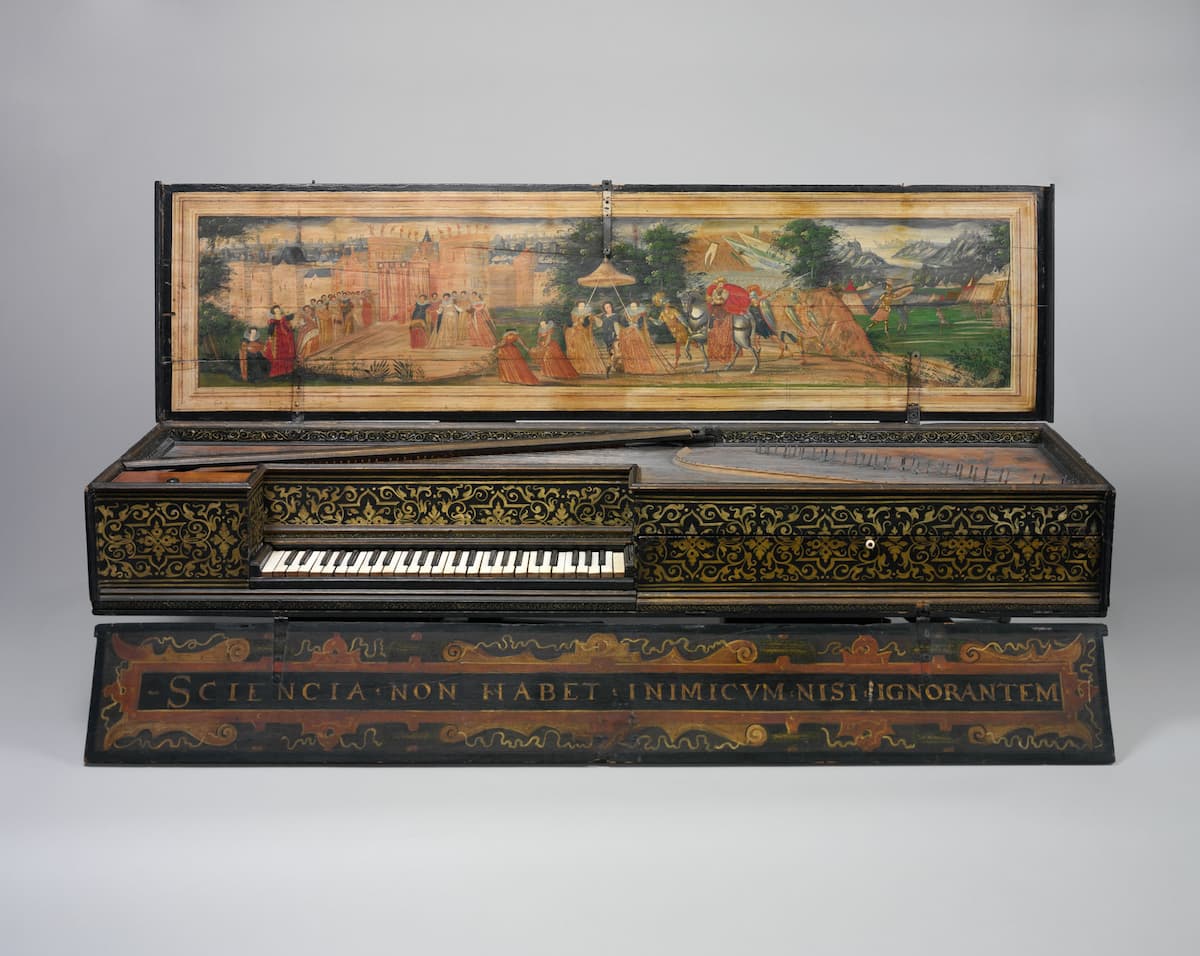
Double virginal closed, Lodewiick Growels, 1600 (Metropolitan Museum of Art)
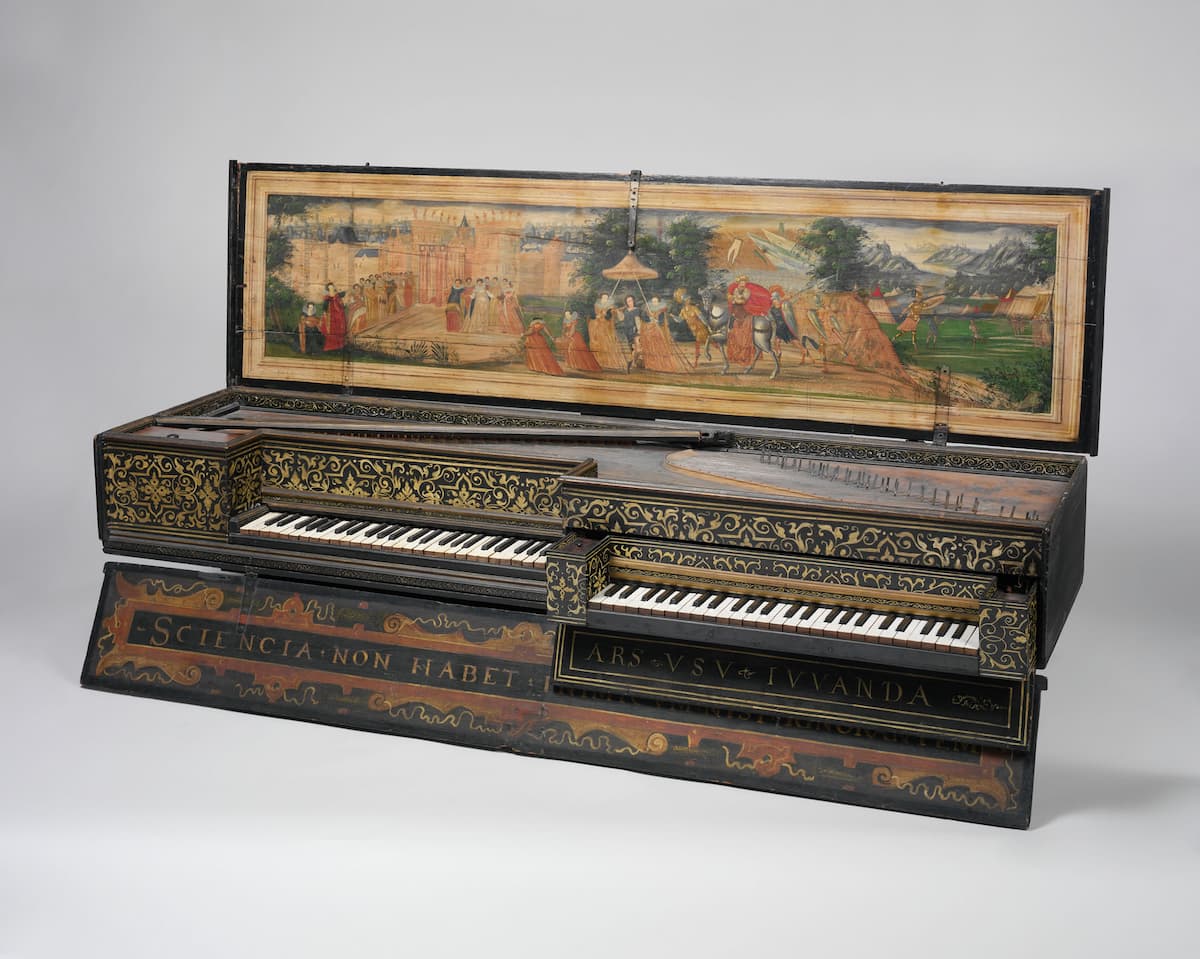
Double virginal with child keyboard exposed, Lodewiick Growels, 1600 (Metropolitan Museum of Art)
This double virginal, made by Lodewiick Grouwels, a Flemish musical instrument maker who worked in The Netherlands, is called a ‘mother and child virginal.’ The smaller keyboard on the right, here shown closed and open, was removable. In 1593, Grouwels, a Protestant, left Catholic Antwerp and relocated to Protestant Middelburg, a Calvinist stronghold. The image on the cover shows one of the legendary Old Testament battles: David versus Goliath. ‘On the far right can be seen the battle between the young David with his slingshot and the giant Goliath. In the lid’s centre is a procession showing David with the head of his slain adversary. On the left are the city gates of Middelburg. The story was likely a metaphor for Protestant Middelburg, part of the United Netherlands since 1581, which bordered the Catholic Spanish Netherlands. (Ben Hebbert 2016).’
Robert Johnson: Pavan (from The Fitzwilliam Virginal Book) (Charles Metz, virginal)
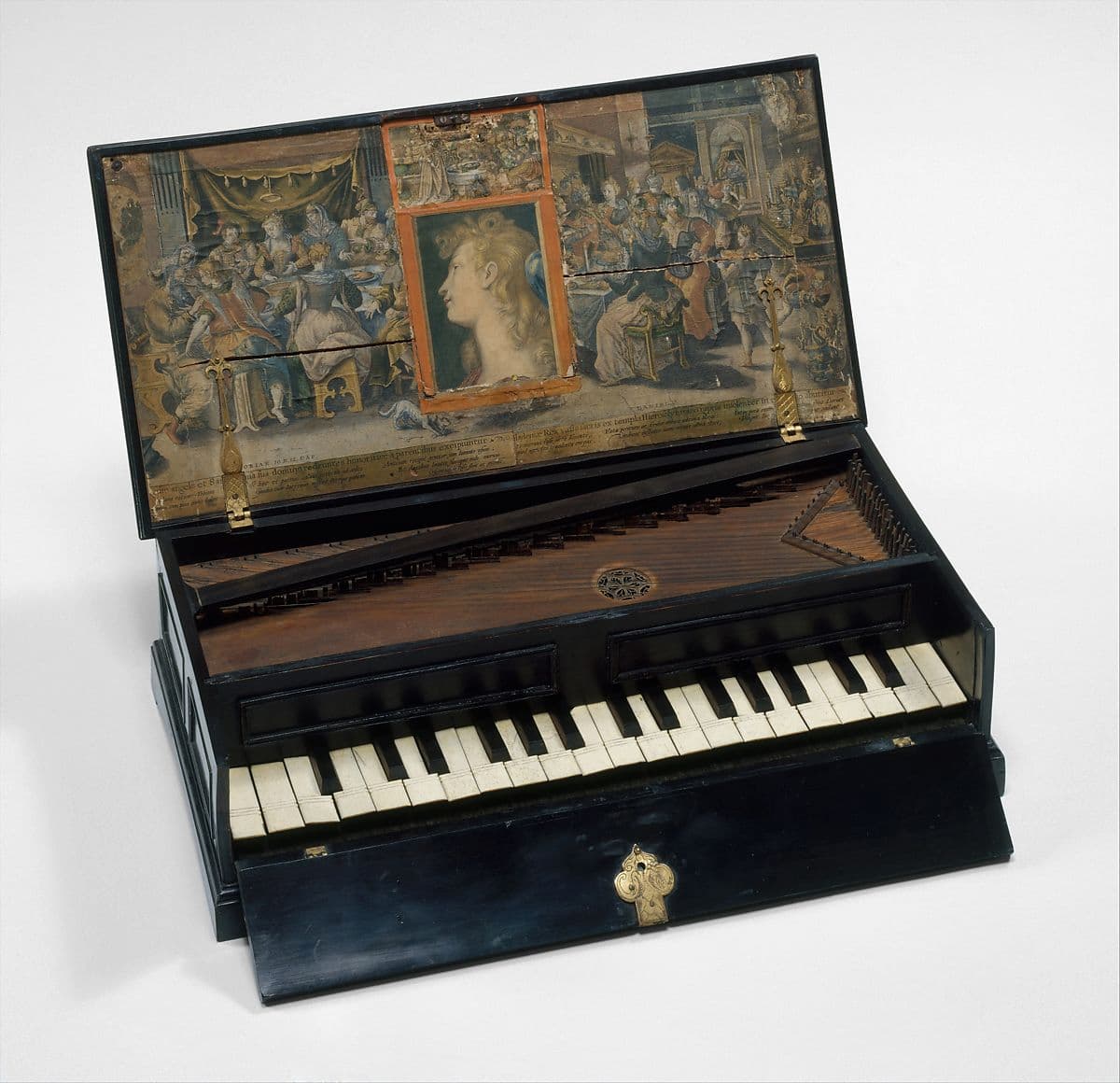
German Rectangular Octave Virginal, unknown maker, circa 1600 (Metropolitan Museum of Art)
This small virginal, also from around 1600, was intended for a lady’s parlour. When closed, it served as a sewing box, with two shallow drawers in the lid, and open, it was a small keyboard to be used for informal music making and to accompany singing. It has an incomplete keyboard, with 2 black keys missing at the bottom, but the range would be suitable for women’s voices. It is of German origin and probably comes from Augsburg. The decorations inside the cover are by Hans Sebald Beham and the elder Crispijn van de Passe – on the left is an illustration of 3 chapters from the book of Tobias and the other from the book of Daniel.

Virginal, Hans Ruckers, 1583 (Paris: Music Museum at the Philharmonie)
Another virginal from twenty years earlier made by Hans Ruckers has decoration both on the outside and inside of the box. The outside decoration has foliage scrolls with animals and insects, and the soundboard has various flowering plants and is dated 1583. The inside of the cover, however, shows a lively hunting scene with men and dogs, while the right background shows a hostelry with a signboard of a swan, and the left is a large house with a tower. The two medallions on the front, which may have been added later, are Catherine de Medici and Diane de Poitiers.

Harpsichord, Andreas II Ruckers, 1646, renovated Pascal Taskin, 1780 (Paris: Music Museum at the Philharmonie)
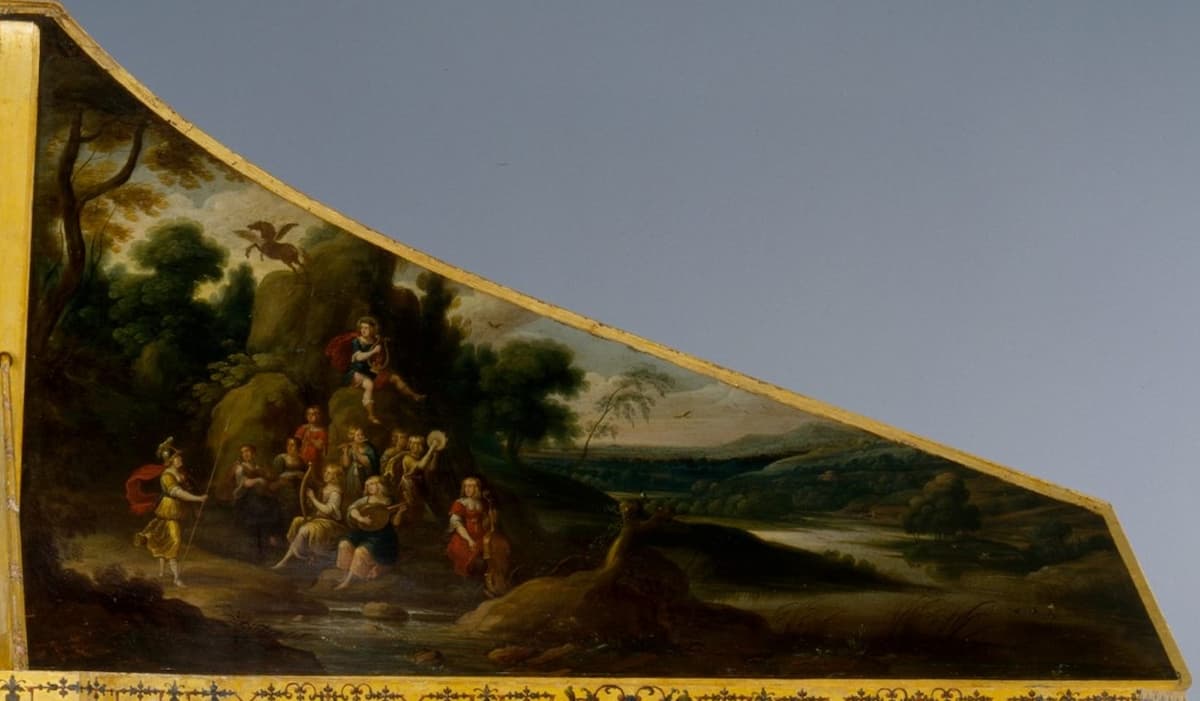
Inside the Cover
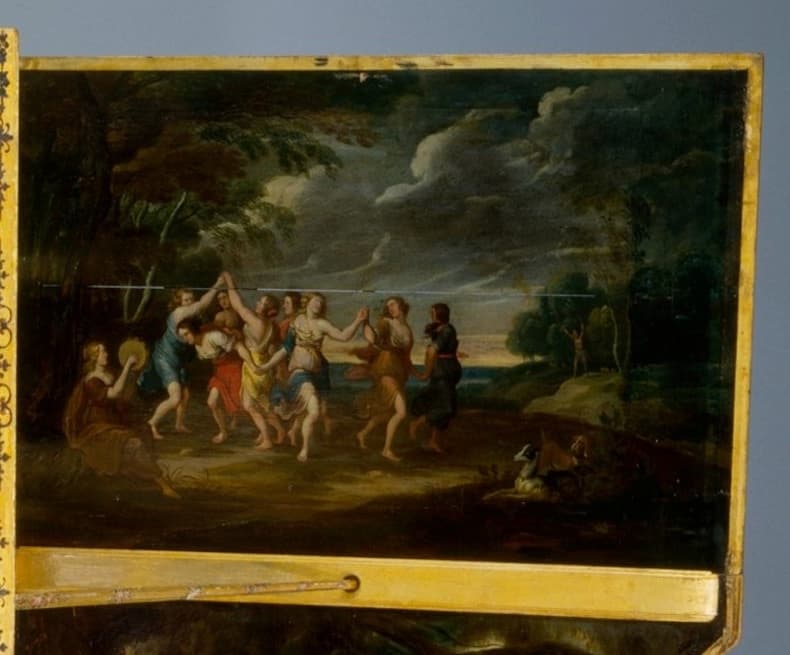
Inside the Keyboard Cover
A Ruckers harpsichord from 50 years later, built by Andreas II Ruckers in 1646, shows the greater refinement that the 18th century could achieve in decoration. The instrument is from the mid-17th century, and the internal decoration is from the 17th century and the external is from the 18th century but predates a renovation of the instrument undertaken in 1780. Inside the cover shows the goddess Athena in her armour, visiting the Muses, who are in concert with Apollo. Inside the cover over the keyboard, which could be folded open while the main body remained closed, shows Diana dancing with her followers. Everything on the harpsichord that could be decorated was decorated – the entire body of the instrument, and every surface inside. The decoration on the outside of the box is in the style of the decorators Berain and Audran. Jean Berain and Claude III Audran were known for their development of arabesque designs.
Louis Couperin: Pavane in F-Sharp Minor (Bob van Asperen, harpsichord)
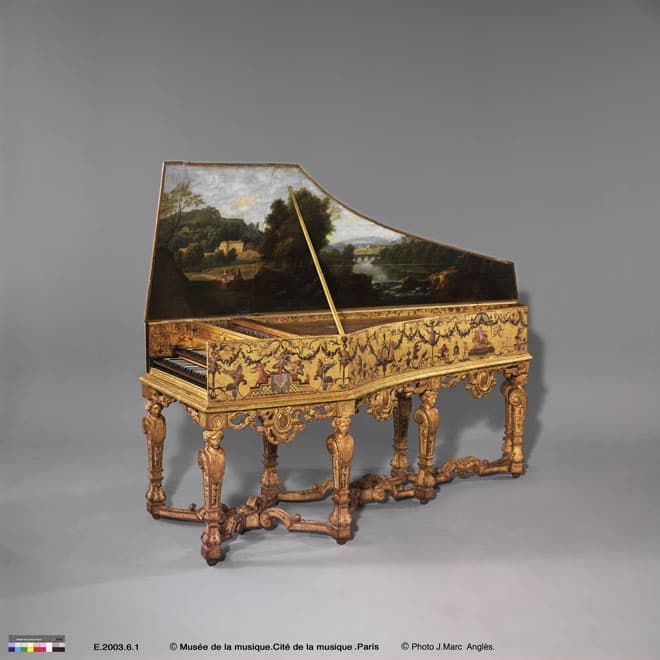
Harpsichord, Ioannes Couchet, 1652, renovated 1701 (Paris: Music Museum at the Philharmonie)
A harpsichord built in 1652 by Ioannes Couchet and then renovated in 1701, is testimony to the durability of the 17th-century Flemish-style harpsichord. It was preferred to update them (in this case, the instrument was enlarged, 4 extra feet were added for support, and a second keyboard was added) than to try and replace them. The instrument’s case has all new decoration, necessary since the instrument was made larger). The decorations are a mix of Flemish and French styles. The soundboard is decorated by flora and fauna, the case with garlands of flowers, grotesques, fantastic animals, and mythological figures. The inside of the case has a large landscape painting that extends over the full cover (unlike the Ruckers decoration above). The base is an extraordinarily original work with caryatids and gilding.
The 18th century saw the decline of the harpsichord and the rise of the piano to the effect today that almost no harpsichords are in private homes and pianos are everywhere.
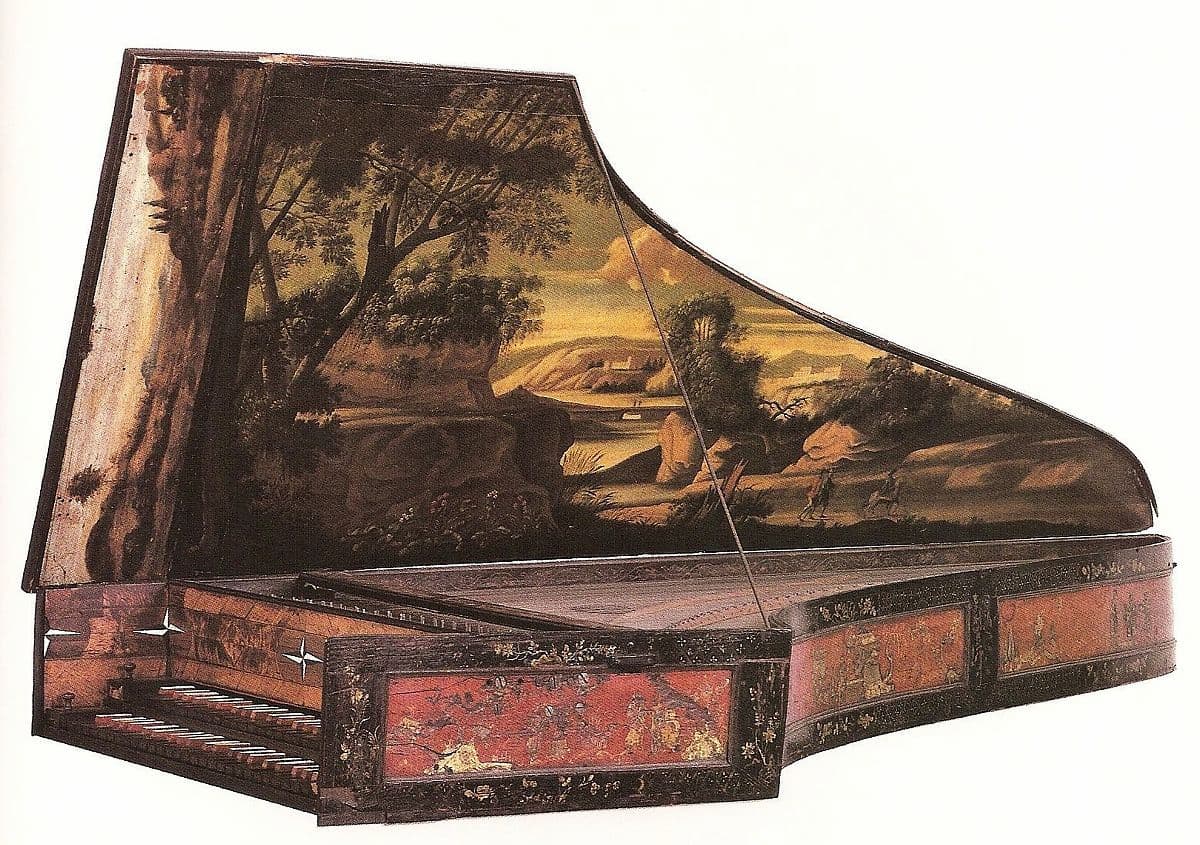
Claviorganum, Herman Willenbrock, 1712 (Metropolitan Museum of Art)
We’ll start with one of the last of the 18th-century harpsichords. This German harpsichord from 1712 was actually a combination of harpsichord and organ (only the harpsichord is shown) known as a claviorganum. These instruments continued to be built through the decade (there’s one from 1785 made by Franz Xavier Christoph in the Kunsthistorisches Museum Wien) and even Franz Liszt owned one of these combination instruments. His was called a Harmoniumflügel. The harpsichord can be played on both keyboards and the organ is played only from the lower one. The art inside the cover is again split between the cover for the keys and the keyboard cover. The oil painting inside shows a landscape of Schulenberg Castle. The instrument may have been made for King George I and may have been known by Handel who visited the English court in 1712.
George Frideric Handel: Keyboard Suite No. 5 in E Major, HWV 430 – IV. Air, “Harmonious Blacksmith” – Variations 1-5 (Shin-ichiro Nakano, harpsichord)
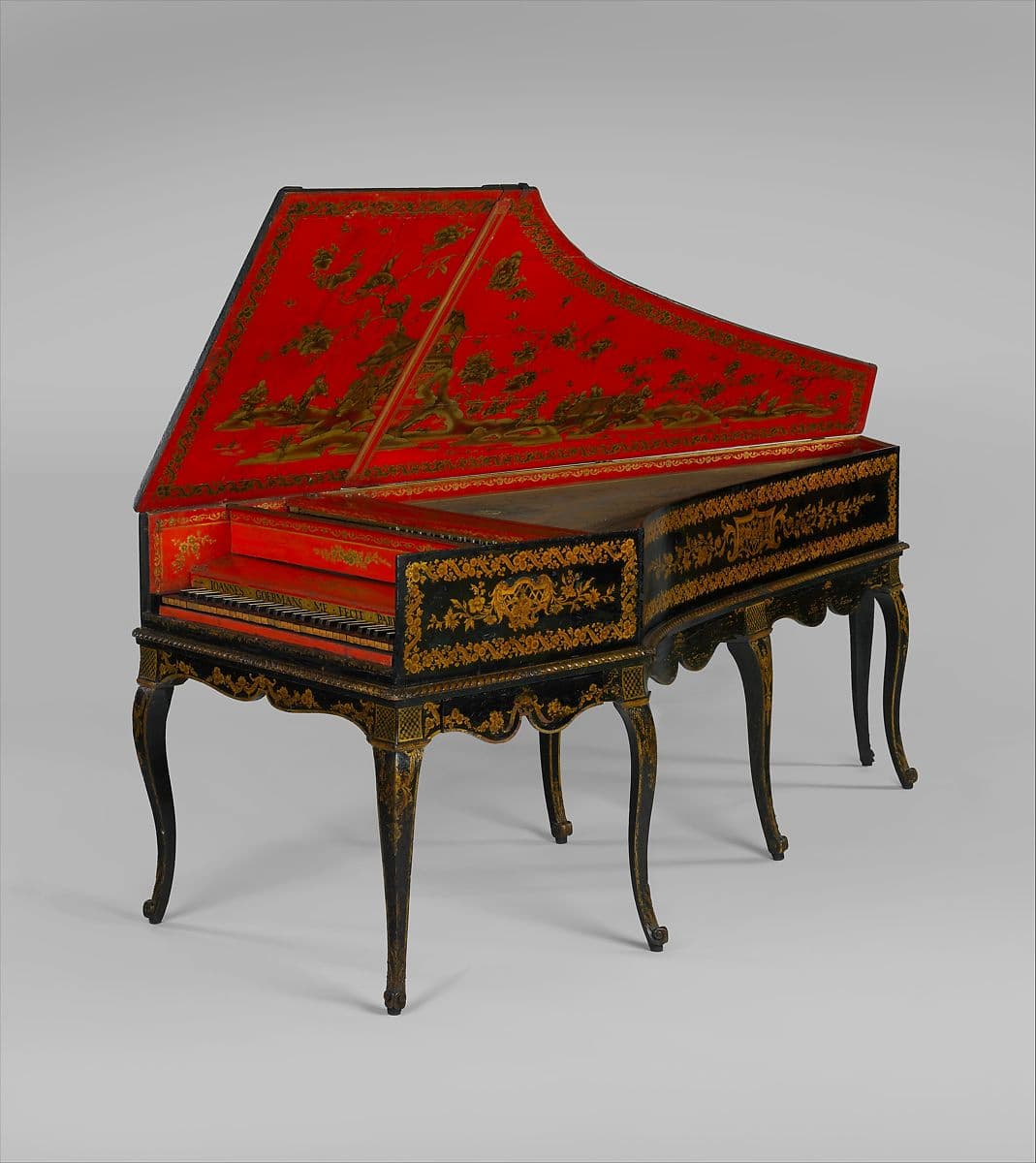
Harpsichord, Ioannes Goermans, 1754, with later piano conversion (Metropolitan Museum of Art)

Lid detail
This French harpsichord reached its greatest popularity in 18th century France, and this instrument from 1754 made by Ioannes Goermans survived the fall of the harpsichord, the destruction of many instruments during the French Revolution in 1789, and was turned into a piano in the late 18th or early 19th century. This instrument would originally have had two keyboards and three sets of strings and in the conversion, the top keyboard was removed along with one set of strings. The black case is decorated in gilt with flora and fauna, and small lattice decorations. The separate stand, with 7 legs, has a similar style of artwork. Inside the case, the red background is decorated with chinoiserie-style painting, including a Chinese-style pavilion and Asian musicians playing European instruments including the violin, the viola da gamba, the hurdy-gurdy, and, of course, a harpsichord.
Jean Henri d’Anglebert: Suite No. 1 in G Major – Menuet (Francesco Cera, harpsichord)
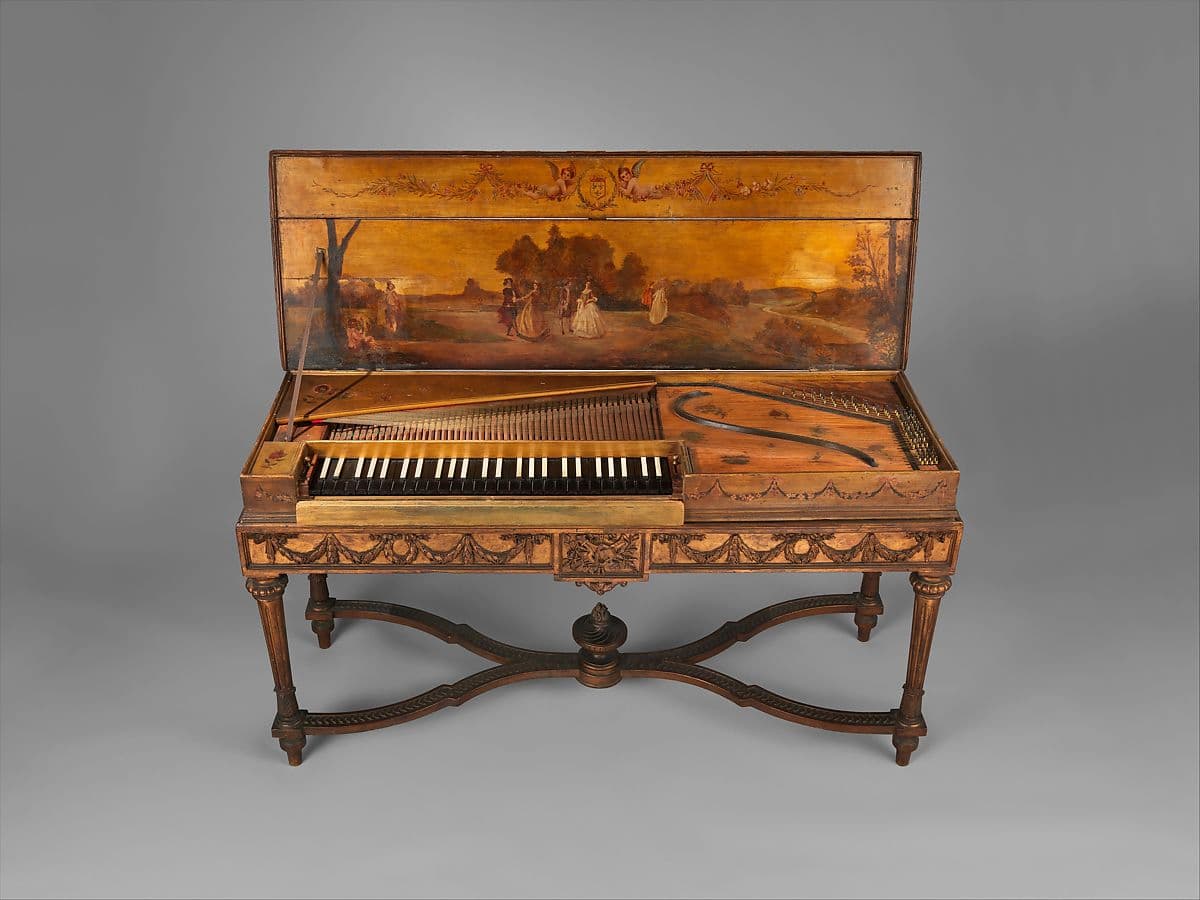
Clavichord, Christian Kintzing, 1763 (Metropolitan Museum of Art)
This little clavichord was built in 1753 and is attributed to the German maker Christian Kintzing. When closed, the instrument is a nice rectangular table and, when opened, a lovely 18th-century landscape would be revealed. This instrument was designed to either be fully opened or opened enough just to expose the keyboard, in which case a coat of arms would be revealed. Kinstzing worked with the cabinet maker David Roentgen in creating these works.
W.F. Bach: Fantasia in A Minor, Fk. 23 – Fantasia in A Minor, Fk. 23 (Sigrun Stephan, clavichord)
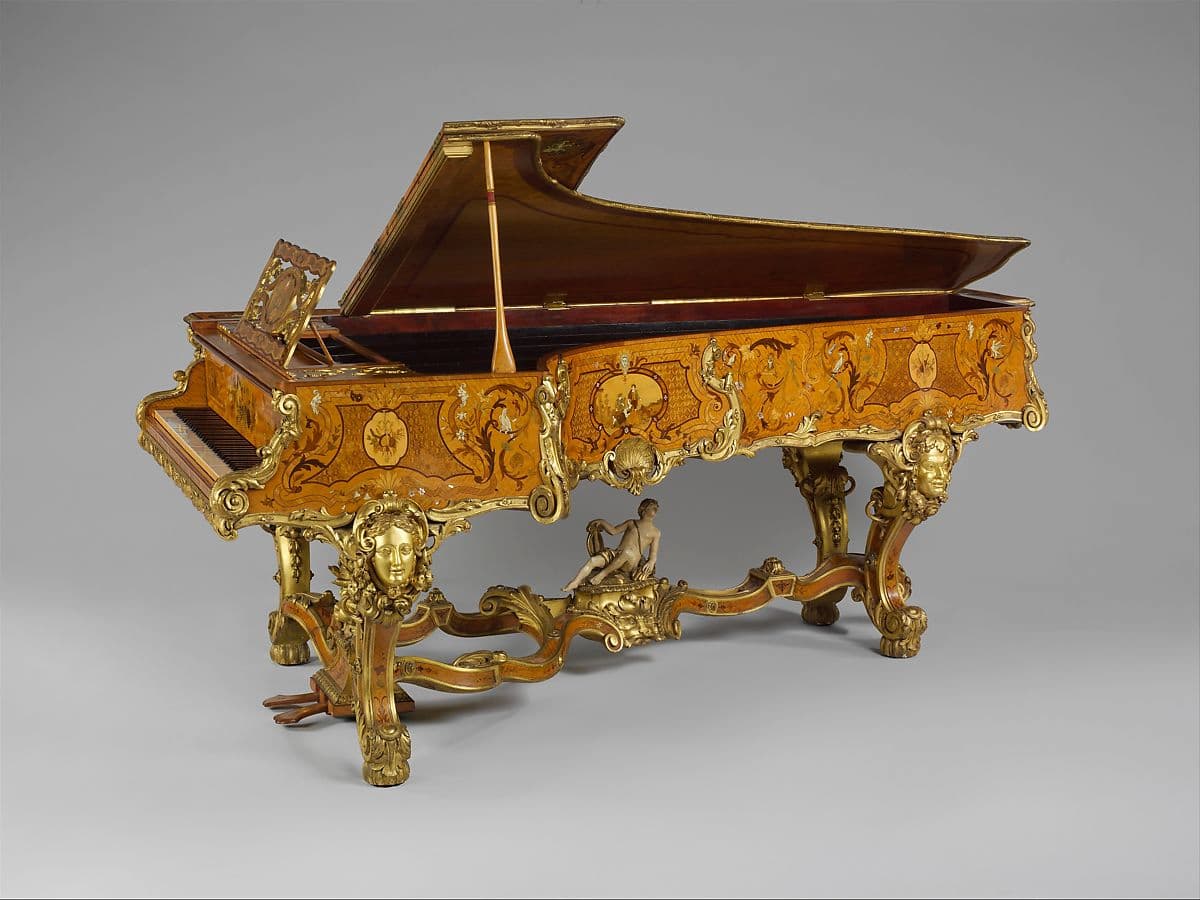
Grand Pianoforte, Érard, ca. 1840 (Metropolitan Museum of Art)
With the rise of the piano, the inside of the case became less important than the outside of the case. In 1840, the Baron of Kidderminster, Thomas Henry Foley, commissioned the French piano makers Érard for a grand pianoforte and this extraordinary case was the result. The primary wood is satinwood, with marquetry that uses a variety of woods including holly, mahogany, burl walnut, and tulipwood, with further decoration in mother-of-pearl, ivory, and silver wire. The imagery is both mythological and related to the Foley family. ‘When closed, the center of the lid top features a large music-themed marquetry trophy with instruments that include a hurdy-gurdy, tambourine, viol and bow, lute, panpipes, hunting horn, French horn, and sheets of music and a volume of Beethoven’s symphonies. The elaborate lid decorations also feature images of animal and human grotesques and floral sprays as well as representations of ivory of Persephone, Ceres, and Bacchus. The lid, case sides, and key flap also feature extraordinary marquetry and scenes of everyday life such as a woman and child warming themselves by a fire, a shepherd boy with a dog, and figures making music or dancing. The exposed underside of the lid flap has a large decoration of the Foley family coat-of-arms with two lion supporters.’ The masks at the top of each leg are of the gods Bacchus and Apollo and the goddesses Diana and Venus, and are said to be likenesses of Foley family members.
Frédéric Chopin: Nocturne No. 17 in B Major, Op. 62, No. 1 (Ksenia Kouzmenko, 1863 Érard)
The 19th-century style removed these kinds of decorative flourishes. A piano like the Érard is a one-off. However, we want pianos to be less statements of art and more instruments in their own right. You never know what you’ll see when you look under a lid, though.
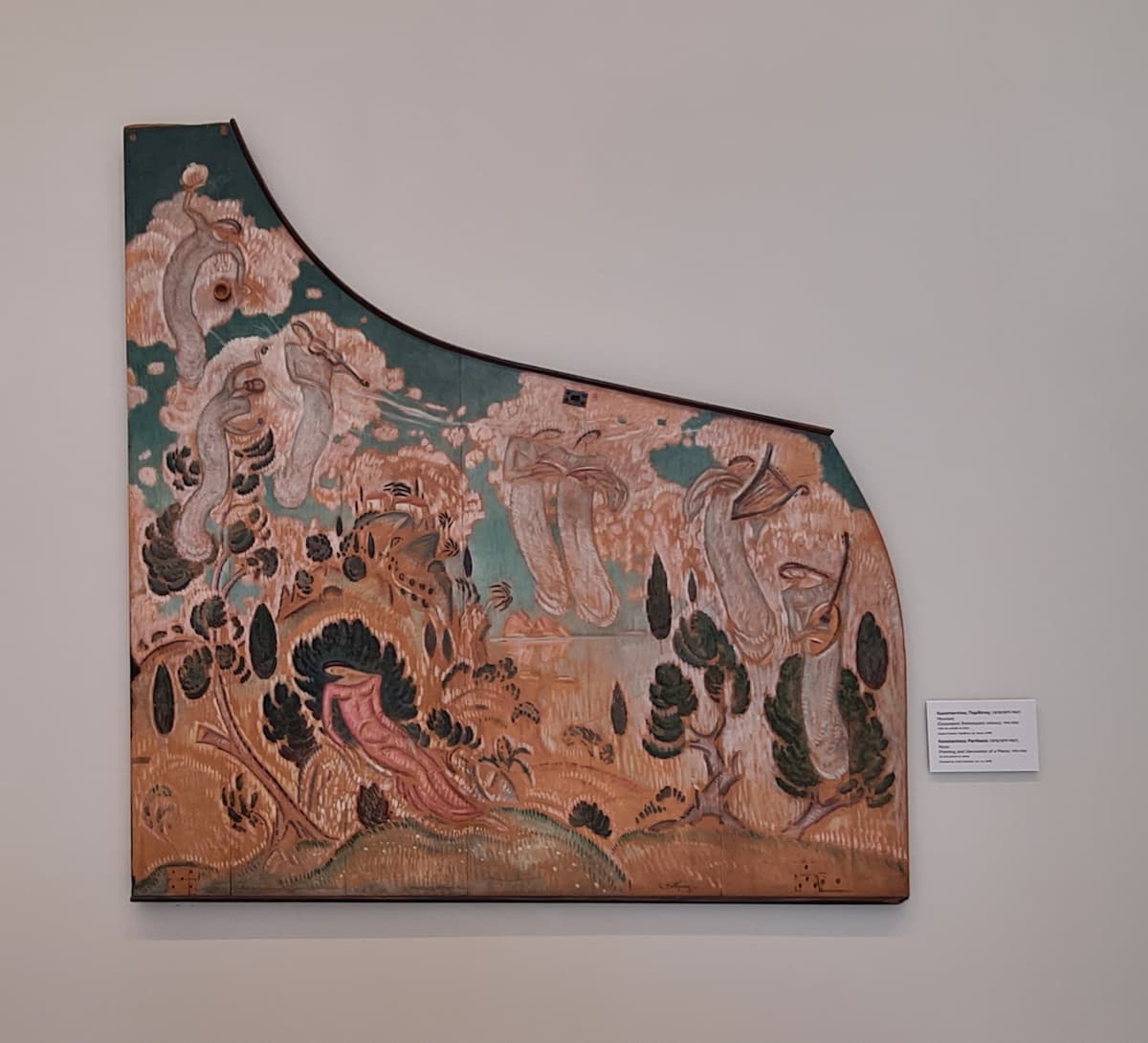
Piano lid, Konstantinos Parthensis, 1915-1920 (Greek National Gallery)
We are closing with a 20th-century decorated lid. To come up to modern times, the Egyptian-Greek painter Konstantinios Parthensis decorated this piano lid around 1915-1920, on the theme of music. As the woman sleeps, cradled in a bush, celestial beings play instruments like the violin and percussion, the lyre and the lute, and sing from part books. In his modern flowing style, Parthensis carries us back to the earliest decorated keyboards, looking to mythology to illustrate the music. This is the only example we have of a lid without the piano, but as this is in an art museum and not a musical instrument museum, that may not be surprising.
For more of the best in classical music, sign up to our E-Newsletter
Loris Margaritis: Piano Sonatina, Op. 5 (Apostolos Palios, piano)
